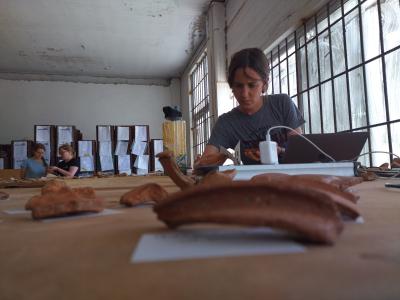An open-air sanctuary used between the Protogeometric and the Classical periods (roughly 1000 to 400 BCE) was recently identified on the western part of the summit of the Anavlochos massif in East Crete. The sanctuary was first located in 2016 by the Anavlochos Project, which is directed by Florence Gaignerot-Driessen (University of Cincinnati) and operates under the auspices of the École française d’Athènes and with the permission of the Hellenic Ministry of Culture and Sports. It was excavated in 2017 and 2018. A group of female figurines and plaques were deposited as votive offerings in bedrock crevices, as well as many sherds of ceramic vessels; no architecture was documented. Though the nearby settlement (also excavated by the project) was abandoned in the early seventh century BCE, local people continued to make the journey to the sanctuary for at least three more centuries (circa 700 to 400 BCE). This sanctuary thus represents an important focal point in the landscape and suggests persistent ritual practice across a time of profound demographic and social change on Crete.
With the help of Stahl funding, I was able to join the Anavlochos team for four weeks in June of 2024 to continue work on analyzing the ceramic finds from this sanctuary (known as Deposit 1). I finished sorting ceramic material from all stratigraphic units and selected particularly diagnostic examples for cataloging. Other team members, including Sabine Sorin and Marie-Christine Levesque, helped to draw and 3-D scan important sherds. I also began to define macroscopic fabric groups for the pottery and started to calculate minimum vessel numbers (MNV) for select shapes. I will continue with this work in the summer of 2025, but analysis so far has provided insight into the activities conducted at the sanctuary: in addition to the ritual deposition of female figurines, there is evidence for drinking and serving (cups and jugs), food preparation and storage (cooking pots, basins, and pithoi), and lighting (braziers or lamps, perhaps suggesting nighttime ceremonies). Some special ritual vessels in the assemblage include votive shields and basins with protomes of griffins, rams, birds. Many of the vessels are in very small pieces, which may suggest that they were deliberately broken at the sanctuary.
This study will ultimately result in a contribution to the final publication of the Anavlochos Excavations (a peer-reviewed academic monograph in the Études Cretoises series). I have worked as staff on this project since 2017, assisting with five seasons of excavation in the site’s settlement, sanctuaries, and cemetery. More information about the Anavlochos Project and its preliminary publications can be found at the project website (https://anavlochos.hypotheses.org/).






